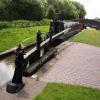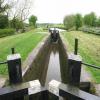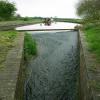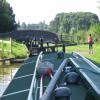
This is a lock with a rise of 8 feet.
| Sandy Lane Bridge No 81 | 1 mile, ¼ furlongs | |
| Gayton Brook Aqueduct | 6¼ furlongs | |
| Weston Bridge No 80 | 5¾ furlongs | |
| Weston Bridge Aqueduct | 5½ furlongs | |
| Weston Salt Works Arm | 2¼ furlongs | |
| Weston Lock No 24 | ||
| Brinepit Bridge No 79 | a few yards | |
| Ingestre Winding Hole | 3½ furlongs | |
| Amerton Brook Aqueduct | 3¾ furlongs | |
| Ingestre Bridge No 78 | 4½ furlongs | |
| Pasturefields Bridge No 77 | 1 mile, 2¾ furlongs | |
Amenities nearby at Weston Salt Works Arm
- Trent & Mersey Canal Society – founded in 1974 — associated with Trent and Mersey Canal
Mouseover for more information or show routes to facility
Nearest water point
In the direction of Great Haywood Junction
In the direction of Etruria Junction
Nearest rubbish disposal
In the direction of Great Haywood Junction
In the direction of Etruria Junction
Nearest chemical toilet disposal
In the direction of Great Haywood Junction
In the direction of Etruria Junction
Nearest place to turn
In the direction of Great Haywood Junction
In the direction of Etruria Junction
Nearest self-operated pump-out
In the direction of Etruria Junction
Nearest boatyard pump-out
In the direction of Great Haywood Junction
In the direction of Etruria Junction
Rugeley Trent Valley... All Change! from Scribblings from the Mintball posted Tuesday the 24th of September, 2013
Wikipedia has a page about Weston Lock
Weston Lock is a canal lock situated on the River Avon, on the western outskirts of Bath, England, in what now forms the Newbridge suburb of Bath.
The Bristol Avon Navigation, which runs the 15 miles (24 km) from the Kennet and Avon Canal at Hanham Lock to the Bristol Channel at Avonmouth, was constructed between 1724 and 1727, following legislation passed by Queen Anne, by a company of proprietors and the engineer John Hore of Newbury. The first cargo of 'Deal boards, Pig-Lead and Meal' arrived in Bath in December 1727. The navigation is now administered by the Canal & River Trust.
Weston cut is a man-made channel, opened in 1727, for boats to approach and pass through Weston lock, which created an island between the cut and the river weir, which became known as Dutch Island named after the owner of the brass mill established on the river side in the early 18th century.
The Dolphin Inn next to the lock was built for bargees in 1728. It is a Grade II listed building.








![Beware the cill in a canal lock. The cill which MUST be avoided by boat crews descending the lock is clearly in view in the image. Catching the stern of the boat on this as the water drains from the lock can result in the boat flooding from the bow and sinking.Brinepit Lock (Weston Lock) here is No 24 on the Trent and Mersey Canal. The lock provides a rise of eight feet (2·4 metres). The top gate set up needs some maintenance as it is leaking.[[[6320493]]] by Roger D Kidd – 17 September 2019](https://s2.geograph.org.uk/geophotos/06/32/04/6320498_7c2448aa_120x120.jpg)













![Weston Lock and Brinepit Bridge in Staffordshire. Weston Lock is No 24 on the Trent and Mersey Canal, and provides a fall (or rise) of 8 feet (2·4 metres)See also ([[[553998]]]) by Roger D Kidd – 11 October 2007](https://s3.geograph.org.uk/photos/59/98/599803_1ca1a6ea_120x120.jpg)












